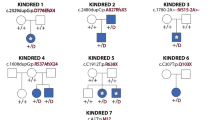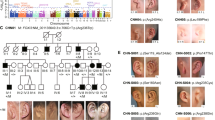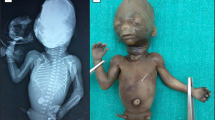Abstract
The DiGeorge/velocardiofacial syndrome (DGS/VCFS) is a relatively common human disorder, usually associated with deletions of chromosome 22q11. The genetic basis for the wide range of developmental anomalies in the heart, glands and facial structures has been elusive. We have investigated the potential role of one candidate gene, Tbx1, which encodes a transcription factor of the T-box family, by producing a null mutation in mice. We found that mice heterozygous for the mutation had a high incidence of cardiac outflow tract anomalies, thus modeling one of the major abnormalities of the human syndrome. Moreover, Tbx1−/− mice displayed a wide range of developmental anomalies encompassing almost all of the common DGS/VCFS features, including hypoplasia of the thymus and parathyroid glands, cardiac outflow tract abnormalities, abnormal facial structures, abnormal vertebrae and cleft palate. On the basis of this phenotype in mice, we propose that TBX1 in humans is a key gene in the etiology of DGS/VCFS.
This is a preview of subscription content, access via your institution
Access options
Subscribe to this journal
Receive 12 print issues and online access
$209.00 per year
only $17.42 per issue
Buy this article
- Purchase on Springer Link
- Instant access to full article PDF
Prices may be subject to local taxes which are calculated during checkout







Similar content being viewed by others
References
Scambler, P.J. The 22q11 deletion syndromes. Hum. Mol. Genet. 9, 2421–2426 (2000).
Goldberg, R., Motzkin, B., Marion, R., Scambler, P.J. & Shprintzen, R.J. Velo-cardio-facial syndrome: a review of 120 patients. Am. J. Hum. Genet. 45, 313–319 (1993).
McLean, S.D., Saal, H.M., Spinner, N.B., Emanuel, B.S. & Driscoll, D.A. Velo-cardio-facial syndrome. Intrafamilial variability of the phenotype. Am. J. Dis. Child. 147, 1212–1216 (1993).
Goodship, J., Cross, I., Scambler, P. & Burn, J. Monozygotic twins with chromosome 22q11 deletion and discordant phenotype. J. Med. Genet. 32, 746–748 (1995).
McDonald-McGinn, D.M. et al. The 22q11.2 deletion: screening, diagnostic workup, and outcome of results; report on 181 patients. Genetic Testing 1, 99–108 (1997).
Gogos, J.A. et al. Catechol-O-methyltransferase-deficient mice exhibit sexually dimorphic changes in catecholamine levels and behavior. Proc. Natl. Acad. Sci. USA 95, 9991–9996 (1998).
Kimber, W.L. et al. Deletion of 150 kb in the minimal DiGeorge/velocardiofacial syndrome critical region in mouse. Hum. Mol. Genet. 8, 2229–2237 (1999).
Lindsay, E.A. et al. Congenital heart disease in mice deficient for the DiGeorge syndrome region. Nature 401, 379–383 (1999).
Puech, A. et al. Normal cardiovascular development in mice deficient for 16 genes in 550 kb of the velocardiofacial/DiGeorge syndrome region. Proc. Natl. Acad. Sci. USA 97, 10090–10095 (2000).
Saint-Jore, B. et al. Goosecoid-like (Gscl), a candidate gene for velocardiofacial syndrome, is not essential for normal mouse development. Hum. Mol. Genet. 7, 1841–1849 (1998).
Wakamiya, M., Lindsay, E.A., Rivera-Perez, J.A., Baldini, A. & Behringer, R.R. Functional analysis of Gscl in the pathogenesis of the DiGeorge and velocardiofacial syndromes. Hum. Mol. Genet. 7, 1835–1840 (1998).
Chieffo, C. et al. Isolation and characterization of a gene from the DiGeorge chromosomal region (DGCR) homologous to the mouse Tbx1 gene. Genomics 43, 267–277 (1997).
Bollag, R.J. et al. An ancient family of embryonically expressed mouse genes sharing a conserved protein motif with the T locus. Nature Genet. 7, 383–389 (1994).
Chapman, D.L. et al. Expression of the T-box family genes, Tbx1–Tbx5, during early mouse development. Dev. Dyn. 206, 379–390 (1996).
Epstein, J.A. et al. Migration of cardiac neural crest cells in Splotch embryos. Development 127, 1869–1878 (2000).
Dahl, E., Kosedi, H. & Balling, R. Pax genes and organogenesis. Bioessays 19, 755–765 (1997).
Stockton, D.W., Das, P., Goldenberg, M., D'Souza, R.M. & Patel, P.I. Mutation of PAX9 is associated with oligodontia. Nature Genet. 24, 18–19 (2000).
Peters, H., Neubuser, A., Kratochwil, K. & Balling, R. Pax9-deficient mice lack pharyngeal pouch derivatives and teeth and exhibit craniofacial and limb abnormalities. Genes Dev. 12, 2735–2747 (1998).
Satokata, I. et al. Msx2 deficiency in mice causes pleiotropic defects in bone growth and ectodermal organ formation. Nature Genet. 24, 391–395 (2000).
Wilkie, A.O.M. et al. Functional haploinsufficiency of the human homeobox gene MSX2 causes defects in skull ossification. Nature Genet. 24, 387–390 (2000).
Wilming, L.G., Snoeren, C.A.S., van Rijswijk, A., Grosveld, F. & Meijers, C. The murine homologue of HIRA, a DiGeorge syndrome candidate gene, is expressed in embryonic structures affected in human CATCH22 patients. Hum. Mol. Genet. 6, 247–258 (1997).
Roberts, C., Daw, S.C.M., Halford, S. & Scambler, P.J. Cloning and developmental expression analysis of chick Hira (Chira), a candidate gene for DiGeorge syndrome. Hum. Mol. Genet. 6, 237–245 (1997).
Farrell, M.J. et al. HIRA, a DiGeorge syndrome candidate gene, is required for cardiac outflow tract septation. Circ. Res. 84, 127–135 (1999).
Wakamiya, M., Rivera-Perez, J.A., Baldini, A. & Behringer, R.R. Goosecoid and Goosecoid-related genes in mouse embryogenesis. Cold Spring Harb. Symp. Quant. Biol. 62, 145–149 (1997).
Yamagishi, H., Garg, V., Matsuoka, R., Thomas, T. & Srivastava, D. A molecular pathway revealing a genetic basis for human cardiac and craniofacial defects. Science 283, 1158–1161 (1999).
Nagy, A., Rossant, J., Nagy, R., Abramow-Newerly, W. & Roder, J. Derivation of completely cell culture-derived mice from early-passage embryonic stem cells. Proc. Natl. Acad. Sci. USA 90, 8424–8428 (1993).
Hogan, B., Beddington, R., Costantini, F. & Lacy, E. (eds.) Manipulating the Mouse Embryo. A Laboratory Manual (Cold Spring Harbor Laboratory Press, Cold Spring Harbor, 1994).
Mallo, M. & Brändlin, I. Segmental identity can change independently in the hindbrain and rhombencephalic neural crest. Dev. Dyn. 210, 146–156 (1997).
Wilkinson, D.G. Whole Mount In Situ Hybridization of Vertebrate Embryos (IRL Press, Oxford, 1992).
Acknowledgements
We thank D. Chapman, J.J. Gibson-Brown, T. Davenport, S. Hancock, N. Adler, K. Hadjantonakis and L. Silver and members of his laboratory for support and helpful criticism; J. Colgan for help with the T-cell analysis; N. Manley for probes; T. Bestor and M. Budarf for critical reading of the manuscript; and M. Bucan for first pointing out that the position of Tbx1 is in a region syntenic to 22q11. This work was supported by NIH grant HD33082 and the Raymond and Beverley Sackler Foundation. L.A.J. was supported by a National Science Foundation predoctoral fellowship.
Author information
Authors and Affiliations
Corresponding author
Rights and permissions
About this article
Cite this article
Jerome, L., Papaioannou, V. DiGeorge syndrome phenotype in mice mutant for the T-box gene, Tbx1. Nat Genet 27, 286–291 (2001). https://doi.org/10.1038/85845
Received:
Accepted:
Issue Date:
DOI: https://doi.org/10.1038/85845
This article is cited by
-
Single-cell transcriptomics uncovers a non-autonomous Tbx1-dependent genetic program controlling cardiac neural crest cell development
Nature Communications (2023)
-
Cellular and molecular mechanisms of the organogenesis and development, and function of the mammalian parathyroid gland
Cell and Tissue Research (2023)
-
Clinical Practice Guidelines for the Immunological Management of Chromosome 22q11.2 Deletion Syndrome and Other Defects in Thymic Development
Journal of Clinical Immunology (2023)
-
Chromatin regulators in the TBX1 network confer risk for conotruncal heart defects in 22q11.2DS
npj Genomic Medicine (2023)
-
Identification and characterisation of spontaneous mutations causing deafness from a targeted knockout programme
BMC Biology (2022)



